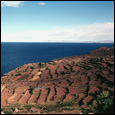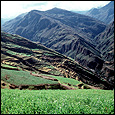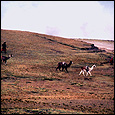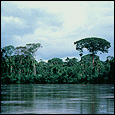| |
PHYSICAL ENVIRONMENT
 ndean culture developed in response to some of the harshest geographic conditions in the world. The region of the Andes encompasses the earthÆs most rugged mountain chain, a vast coastal desert, sierra basins, high puna, and tropical rainforest. The coast and mountains run parallel from north and south and are bisected by rivers that run from east to west. Cultures developed in isolated valleys near rivers. For millenia, the inhabitants of the Andes, like South Americans today, have had to endure active volcanoes and earthquakes, as well as severe flooding and droughts caused by the El Ni±o phenomenon. Nonetheless, Andean cultures mastered the ability to meet human needs by working with the natural rhythms of the landscape.
ndean culture developed in response to some of the harshest geographic conditions in the world. The region of the Andes encompasses the earthÆs most rugged mountain chain, a vast coastal desert, sierra basins, high puna, and tropical rainforest. The coast and mountains run parallel from north and south and are bisected by rivers that run from east to west. Cultures developed in isolated valleys near rivers. For millenia, the inhabitants of the Andes, like South Americans today, have had to endure active volcanoes and earthquakes, as well as severe flooding and droughts caused by the El Ni±o phenomenon. Nonetheless, Andean cultures mastered the ability to meet human needs by working with the natural rhythms of the landscape.
|



 ndean culture developed in response to some of the harshest geographic conditions in the world. The region of the Andes encompasses the earthÆs most rugged mountain chain, a vast coastal desert, sierra basins, high puna, and tropical rainforest. The coast and mountains run parallel from north and south and are bisected by rivers that run from east to west. Cultures developed in isolated valleys near rivers. For millenia, the inhabitants of the Andes, like South Americans today, have had to endure active volcanoes and earthquakes, as well as severe flooding and droughts caused by the El Ni±o phenomenon. Nonetheless, Andean cultures mastered the ability to meet human needs by working with the natural rhythms of the landscape.
ndean culture developed in response to some of the harshest geographic conditions in the world. The region of the Andes encompasses the earthÆs most rugged mountain chain, a vast coastal desert, sierra basins, high puna, and tropical rainforest. The coast and mountains run parallel from north and south and are bisected by rivers that run from east to west. Cultures developed in isolated valleys near rivers. For millenia, the inhabitants of the Andes, like South Americans today, have had to endure active volcanoes and earthquakes, as well as severe flooding and droughts caused by the El Ni±o phenomenon. Nonetheless, Andean cultures mastered the ability to meet human needs by working with the natural rhythms of the landscape.


